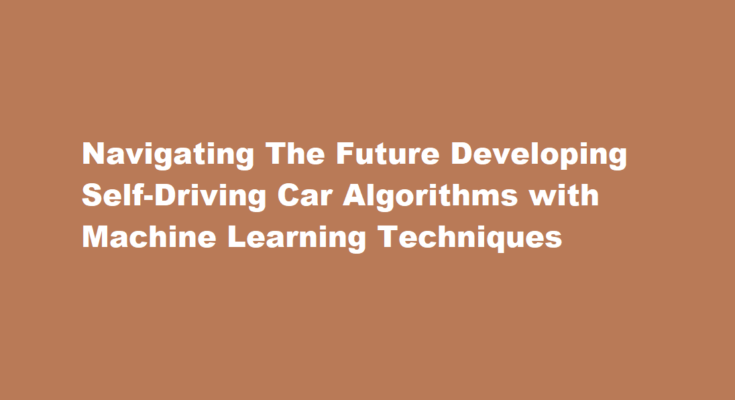Introduction
The quest for self-driving cars has captured the imagination of engineers and researchers worldwide. These autonomous vehicles have the potential to revolutionize transportation by increasing safety, reducing traffic congestion, and improving energy efficiency. At the heart of every self-driving car lies a sophisticated algorithm that enables it to navigate complex environments and make real-time decisions. In this article, we will explore the process of developing a self-driving car algorithm using machine learning techniques.
Understanding the Basics
Before delving into the specifics, it’s essential to grasp the fundamental components of a self-driving car system
1. Sensors Self-driving cars are equipped with an array of sensors, including cameras, LiDAR (Light Detection and Ranging), radar, and GPS, which provide data about the car’s surroundings.
2. Perception The first step in the algorithm is perception. This involves processing the sensor data to identify objects like other vehicles, pedestrians, traffic signs, and road lanes. Convolutional Neural Networks (CNNs) and other deep learning techniques are commonly employed for image and sensor data analysis.
3. Localization Once the car understands its environment, it needs to know its precise location. GPS data is often fused with sensor data to achieve centimeter-level accuracy.
4. Mapping Self-driving cars rely on high-definition maps to navigate. These maps contain information about road geometry, lane markings, traffic signs, and more. Creating and updating these maps is a continuous process.
5. Planning The planning module takes the information from perception, localization, and mapping to make decisions. It generates a path that the vehicle should follow and determines how it should navigate obstacles and follow traffic rules.
6. Control The control system translates the planned path into specific vehicle movements, such as steering, acceleration, and braking. PID controllers and Model Predictive Control (MPC) are often used for this purpose.
Machine Learning in Self-Driving Cars
Machine learning plays a pivotal role in the development of self-driving car algorithms. Here’s how it is integrated into various components
1. Perception Convolutional Neural Networks (CNNs) are used to analyze sensor data, making it possible for the car to recognize objects, pedestrians, and road signs. These networks are trained on massive datasets to improve accuracy.
2. Localization Machine learning algorithms can enhance GPS accuracy by fusing it with data from other sensors. Kalman filters and Particle filters are commonly used for sensor fusion.
3. Mapping Machine learning can assist in creating and updating high-definition maps. Simultaneous Localization and Mapping (SLAM) techniques use sensor data to construct and refine maps of the vehicle’s surroundings.
4. Planning Reinforcement learning and deep reinforcement learning can be employed to create decision-making models. These algorithms learn from real-world driving experiences to optimize driving strategies.
5. Control Machine learning algorithms can optimize vehicle control, ensuring smoother and more efficient driving. Advanced control techniques, such as MPC, can adapt to changing road conditions and traffic scenarios.
Challenges and Considerations
Developing a self-driving car algorithm is a complex and resource-intensive endeavor. Some of the key challenges and considerations include
1. Data Collection Collecting vast amounts of data from real-world driving scenarios is crucial for training machine learning models. This requires fleets of test vehicles and specialized data collection equipment.
2. Safety and Reliability Ensuring the safety and reliability of self-driving cars is paramount. Extensive testing, redundancy, and fail-safe mechanisms are essential to mitigate risks.
3. Regulations Navigating the regulatory landscape is a significant hurdle. Self-driving cars must comply with a complex web of local, state, and federal regulations.
4. Hardware Building the hardware infrastructure to support self-driving cars, including powerful computers for real-time processing and robust sensor suites, is a significant investment.
5. Ethical Considerations Self-driving cars must be programmed to make ethical decisions in complex situations, such as the famous “trolley problem.”
The Development Process
Developing a self-driving car algorithm involves an iterative process that combines software development, machine learning, and rigorous testing. Here’s a simplified overview of the typical development stages
1. Data Collection Gather sensor data from test vehicles in various real-world scenarios. This data serves as the foundation for training and testing machine learning models.
2. Data Preprocessing Clean, label, and preprocess the collected data to make it suitable for machine learning algorithms.
3. Model Training Train machine learning models, such as CNNs for perception or reinforcement learning agents for planning, using the preprocessed data.
4. Simulation Use simulators to extensively test the algorithms in virtual environments before deploying them in real-world situations. Simulation helps identify and resolve potential issues safely.
5. Real-world Testing Gradually transition to on-road testing with safety drivers who can intervene if necessary. Collect additional data to further refine the algorithms.
6. Iteration and Improvement Continuously iterate on the algorithms based on real-world feedback and new data. The development process is ongoing to enhance safety and performance continually.
FREQUENTLY ASKED QUESTIONS
What type of programming is in self-driving cars?
In programming terms, the language of the self-driving car is C++. But in real-world terms, the language issue is far broader.
Which AI model is used in self-driving cars?
Deep learning, a type of machine learning that involves training artificial neural networks on large datasets, is widely used in the development of self-driving cars.
What type of AI is used in Tesla cars?
Tesla’s Autopilot system uses AI algorithms (Convolutional Neural Networks, Recurrent Neural Networks, and Reinforcement learning) to enhance the performance of the car’s advanced driver assistance features.
Conclusion
Developing a self-driving car algorithm using machine learning techniques is a multifaceted endeavor that combines cutting-edge technology, extensive data collection, and rigorous testing. While the challenges are substantial, the potential benefits, including increased road safety and reduced traffic congestion, make the effort worthwhile. As the field of autonomous vehicles continues to evolve, advancements in machine learning and artificial intelligence will play a crucial role in bringing us closer to a future where self-driving cars are a common sight on our roads.
Read Also : Building a Fully Functional AI-Powered Virtual Assistant from Scratch



